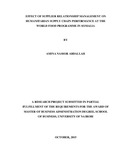| dc.description.abstract | Supplier Relationship Management is understood as the sourcing policy
-
based design of
strategic and operatio
nal procurement processes as well as the configuration of the
supplier managemen
t.
Coordination
in humanitarian organizations
is often difficult
because of the many groups involved (mili
tary, government,
Non
-
governmental
Organizations
), and
often inadequa
te infrastructure. Moreover,
in
humanitarian
supply
chain,
the “customer” is
usually
the donor or supplier of goods, rather than the recipient
of the aid the
programme
is designed to help. These donors must be sold by showing the
donation is being used pro
perly
. Although aid effectiveness as an operational goal of
humanitarian organizations is often criticized since it overlooks other goals such as
equity, this does not mean that efficiency should be discarded. This is because
beneficiaries require humanita
rian agencies to demonstrate operational efficiency
especially when disasters strike since this can save lives. This means that an organization
that does not have a supplier relationship management strategy may fail to attain
operational efficiency hence f
ailing to achieve their main objective (saving lives) due to
delayed delivery, high costs and poor quality. This therefore calls for supply relationship
management on the part of
humanitarian agencies.
N
o local study has focused on supply
chain relation
ship among humanitarian organizations; despite the challenges they get in
getting supplies on time due to financing and other constraints, a gap that the present
study aimed to fill by
studying supplier relationship management in humanitarian supply
chain
at the World Food Programme in Somalia. The study aimed to answer the
following question; what is the effect of supplier relationship management on the service
performance of World Food Programme in Somalia?
This study adopted a survey design
.
The populati
on of this study was WFP employees in these three categories: all senior
managers in both the regional and the liaison office; all procurement staff in both the
regional and the liaison office. The study also targeted WFP food suppliers based in
Nairobi. T
he study targeted 7 food suppliers in Nairobi because WFP places a priority on
procuring food supplies from the local community
. This gave us a sample size of 87. The
study collected primary data. Data from WFP employees was collected using self
-
completion
questionnaires
.
For the suppliers, the CEO/Managing Director/Owner
manager or the available senior most employee was be interviewed
.
The data was
analyzed using the IBM Statistical Program for Social Sciences ((SPSS) version 21.
Descriptive statistics was
used to summarize the data
.
the organization always sh
ares
information with suppliers. The results show that
WFP has multiple tier suppliers
. It was
also revealed that
WFP continuously trains employees from then procurement department
and that
WFP has mec
hanisms to ensure suppliers conform to quality standards and is
keen on suppliers of critical commodities like food
. It was also found that
IT is used in
the execution and management of purchase orders and that
the organization’s
humanitarian supply chain
performance, results indicated that WFP Somalia delivers
defect free food supplies
to beneficiaries. The study makes the following
recommendations; WFP’s
management should begin rewarding
suppliers who share
information and that the organization
should no
t only have multiple supply tiers but
should also well unde
rstand each tiers risk profile to
enable the organization mitigate any
unforeseen events that may affect delivery of supplies
especially during emergencies | |

